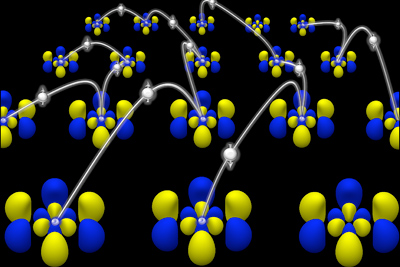Using a microscope, designed to show the arrangement and interrelationships of electrons in crystals, scientists have for the first time ever obtained a picture of electrons adding enormous mass to themselves under extreme conditions.

"Physicists have been interested in the issue of heavy fermions - why these electrons behave as if they have a mass hundreds or even thousands of times greater than their original mass under special conditions - for about forty years," says the person in charge of the research Séamus Davis, professor of physical sciences at Cornell University. Understanding the behavior of heavy fermions could lead to the development of new materials for high temperature superconductors.
In the current study, the scientists tracked the properties of electrons in a material composed of uranium, ruthenium and silicon, a material that itself has been a scientific mystery for 25 years. In this material, the effects of heavy fermions begin to give their signals when the material is cooled to a temperature of minus 218 degrees Celsius. At a temperature of minus 255.65. An even more unusual electronic phase transition occurs.
Scientists attributed this low temperature phase transition to a certain form of "hidden order". They were unable to determine whether it was related to the cooperative behavior of the electrons acting as a wave, or to the interactions of individual electrons with the uranium atoms. Alexander Balatsky, a theoretical physicist at Los Alamos Laboratories, provided guidance on how to solve this question. With this guidance, the research group used a method designed to track the behavior of the electrons to "see" what they were doing during this mysterious phase transition. In the method - scanning tunneling microscopy in spectroscopic imaging (SI-STM) - the wavelengths of electrons on the surface of the material are measured in relation to their energy.
"Imagine that you are flying over a body of water where standing waves move up and down, without moving towards the shore," explains the researcher. “When you go over the tops of the waves, you are able to touch the water; When you pass over the low points - you are not able to touch them. This is similar to what our microscope does - it simulates how many electrons are able to "jump" towards its detector tip at each and every point on the surface." From the measurements of the wavelengths and the amounts of energy the scientists are able to calculate the practical mass of the electron.
"The method revealed to us that we are dealing with very heavy electrons - or electrons that behave as if they are very heavy, since the speed of their movement has decreased slightly," explains the researcher.
The discovery of "heavy electron" properties below the second transition temperature provides direct experimental evidence that the electrons "react" with the uranium atoms and not that they behave as a cooperative wave.
To visualize this, imagine soccer players running towards the opponent's goal at the moment of the kick-off. If each player were free to run unhindered, the whole team would appear to be acting in a wave form of relatively independent "electrons". However, imagine that instead, the court is filled with an array of chairs, and each player must immediately sit on the chair as soon as they come across it before proceeding further down the court. In this case, the chairs are the equivalent of the uranium atoms. These interactions between the actors and the chairs (or the electrons and uranium atoms) clearly slow down progress.
In the case of uranium, the slowing down of the electrons lasts only a fraction of a second in front of each atom in the material. However, since the energy of motion (kinetic energy) and mass are mathematically related, the deceleration results in the measurement of heavier electrons than free electrons.
Besides discovering these interrelationships as the source of the "hidden order" in the uranium compound, the research also shows that the particular method can be used to "watch" heavy electrons. As a result, a window was opened for the development of additional ways to study and observe this phenomenon.
The research team continues to use this method to examine a variety of similar compounds for a deeper understanding of heavy fermion systems. "Heavy fermions remain mysterious in many ways, and it is our job as scientists to resolve this issue," explains the lead researcher.

3 תגובות
Who has seen more of the World Cup?
There is no connection between atomic bombs and electrons. Neutrons are used in atomic bombs.
And also to build a more powerful atomic bomb